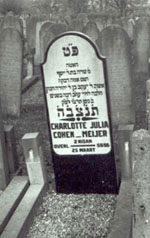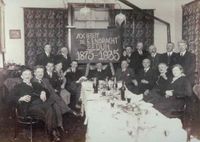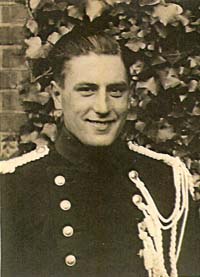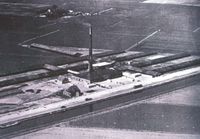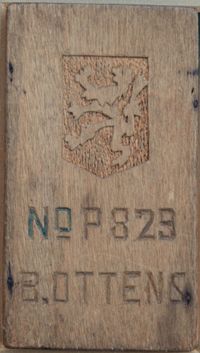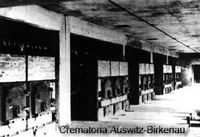In 1998, I moved house together with my spouse and two children. We already lived in Bedum, but preferred an ‘older’ house because we like the particular atmosphere of older houses. My spouse found out that the house at the Schultingastreet –a house built in the 1930s- was up for sale.
Gemeente BedumFrom the outside the building looked fine but it later turned out that the inside needed refurbishment. Many of the authentic building elements were still in place. We nevertheless decided to buy it. When we heard more about the history of our house we decided to keep the house in a state as original as possible and the planned refurbishment remained limited. My neighbour told me that Jewish people had been in hiding in this house during WWII. ‘In our house…’, I thought. And from that moment my curiosity was raised. After some months, an article was published in the Ommelander Courant (a local newspaper). It was a story about a couple called Meijer (no family) and it was written by a certain Mr. van Dis from Bedum.’This is a gentleman I would like to meet,’ I thought.
This is a gentleman I would like to meet .....
I anticipated a brief meeting with Mr Van Dis but after our initial contact many followed, and nowadays we speak each other almost daily. It turned out that Mr. van Dis lived right around the corner of our street. I told him over the phone that I was very interested in the history of the Jewish Meijer family. Dhr. van DisNot even an hour later, Mr. van Dis appeared on our doorstep with a great store of information about Jozef and Regina Meijer. He told me that he interviewed a lot of people during the 1980s in order to gain more information about the history and fate of the Meijer family. Mr van Dis and I agreed that their tragic story should serve a broader purpose. Together we developed the idea to write an educational leaflet for primary schools. We contacted the cultural committee of the municipality of Bedum and with their support produced a wonderful flyer which is still in use in all primary schools in Bedum and which can be downloaded elsewhere on this website. It turned out that Mr. van Dis owned original pictures from Jozef and Regina Meijer. He also provided me with names of people to who could give me more information. He pointed me –for instance- to Mrs Grasdijk who –as a little girl- lived in the house owned by the Meijers. She still had one of their yellow stars of David in her possession. She donated the star, under the condition that it should be used for educational purposes. Her late sister owned the other star. Her brother in law also donated this item.
Taking good care of the original items....
Mr van Dis and I decided to frame all the original items that had a connection with the Meijer family and WWII, in order to preserve them better. But we felt that not only the material items, but also the story behind them should be safeguarded for the future. We had heard that the memorial centre at the former transit camp (Durchgangslager) Westerbork was looking for stories about people who stayed in the camp and who were transported from there to concentration camps in the East. We provided them with two stories which now feature on their website and which in this way will not be forgotten. Just like Mr van Dis, I have spoken with many people who remember the Meijer family and can tell about them. But those people diminish rapidly in number… Waling Lerk and his wife visited us in our house at the Schultingastreet. During WWII, Waling and his family lived in our house and he was a young boy when the Meijers hid in a room on the upper storey. Thanks to him, we know which room they occupied (see his story and photo elsewhere on this site). I also spoke with Mr van Kooten who transported Regina Meijer to a new hiding place on the back of his bicycle. Some time ago, Mr van Dis and I travelled to the Hague to visit the grandson of Sergeant Major ter Horst. He donated a sable that belonged to his grandfather. We enjoyed a visit from the daughter of public notary Wolters and from Mrs Jonkheer-Veldman and her husband. The father of the latter hid Hielke van der Heide and Willem Homoet on his farm (see their story elsewhere on this site).
Visiting primary schools.....
After the education leaflet was produced we thought it a good idea to visitdwangarbeiders-koffer primary schools ourselves and to share our knowledge with the children in the highest grades. The interest was, and is, overwhelming and the enthusiasm infatuating. Mr van Dis still had the original suitcase which he used when he was put on transport as a young man and forced to work in Germany during WWII. This a separate story of course. In this old suitcase we preserve all items connected to the Meijer family we collected over the years and we keep them in the room of our house where they went into hiding. Teachers can also borrow the items, but because of their unique character we are very careful with them. Over the past year, I visited many local schools, and even high schools in the city of Groningen were interested. I thus enjoy the wonderful experience of addressing school classes, even though I am not a teacher! I hope to continue giving these lectures for many years to come, most importantly because I want the story of the only two Jews living in Bedum never to be forgotten. The suffering of these two people is representative of that of six million others. I therefore wish this website to serve as a memorial to Jozef and Regina Meijer as well as to all other victims of the holocaust. In addition, I hope that this website will help readers to realise that many men and women sacrificed their lives for the freedom we now enjoy. Finally, I wish to express my sincere gratitude to all of those who contributed to this website.
Han Meijer, Bedum 28 february 2006.
The Jewish Family Meijer
Jozef and Regina Meijer lived in Bedum at 13 Boterdiep Westzijde (West side of a waterway called Boterdiep). Jozef Meijer was businessman in livestock specialising in trading sheep. Some inhabitants of Bedum still remember him as a quiet gentleman riding his bicycle through the village in search for business. From a distance one could recognise him. He sat straight on the saddle looking out over the fields and his cane was fastened to his bike with a leather strap.
One villager can still remember how he had to look after Jozef Meijer’s sheep one afternoon. There was a slight possibility that one of them could fall into the ditch! This story is indicative of Jozef Meijer’s care for his animals. As a ‘thank you’, the obliging villager received a brand new silver quarter from Jozef. The other quarter Jozef had was worn and he put it back into his large brown leather wallet. The silver quarter has never been spent and has been preserved up until the present day Regina Meijer was an admirer of the Dutch Royal family. As a young woman she had travelled to Amsterdam to witness the coronation of Queen Wilhelmina. This was in the year 1898. Regina was standing at the front of the sidewalk to have a good view. But when the Queen passed, one of the horses reared and hit Regina. She was hurt and the injury would bother her for the rest of her life. The young Queen was very concerned and kind to Regina..
A daughter was born to Jozef and Regina Meijer on October 20th 1909. Her name was Charlotte Julia (in daily life she was called Lotty). She was their only child. Like many Jewish youngsters, she did not stay on to live in the village. After having worked in the laboratory of the local dairy factory in Bedum, she married Joseph Cohen in 1934 and moved to the city of Groningen. Her husband had a fine job at a textile firm in the W.A. Scholten street. But tragedy struck and Lotty became severely ill with an - at that time – incurable disease. She passed away on March 25th 1936. She is buried in the Jewish cemetery ‘Selwerderhof’ in Groningen.
Jozef Meijer was a respected man in the village. There is a picture dating from 1935 which shows him as a member of the exclusive society ‘Eendracht’ (‘Unity’). The man in the lower left hand corner is Jozef Meijer. The society admitted only members of the village elite such as the doctor, the director of the local gas factory, the public notary, the director of the local school and the owner of the hotel in Bedum etc.
The minutes and the account book of the society have been preserved. It is very old. On the first page the date of the first meeting is mentioned: January 1st 1876.
WWII and going into hiding.....
Germany attacked the Netherlands on May 10th 1940 and the Dutch army had to capitulate a few days later. The Germans already had a bad reputation due to their attitudes and behaviour towards Jews. The regular humiliation and isolation of Jews which occurred in Germany and Austria, was also introduced in The Netherlands. From 1940 to 1942 new regulations were proclaimed on a regular base which made life increasingly miserable for many Jews. This also happened in Bedum, even though Jozef and Regina Meijer were the only two Jews living in the village. Signs were put on display: ‘Forbidden for Jews’ and Jozef Meijer was not allowed anymore to be a member of the Society ‘Eendracht”.
In addition, Jozef and Regina Meijer’s identity cards needed to be marked with a ‘J’, meaning Jude, ‘Jew’. They also needed to be registered as Jews at the municipality. They both went to the town hall to fill out the necessary forms on February 13th 1941. With the implementation of these measurements, the Germans knew exactly how many Jewish inhabitants a municipality had and where they lived. Jozef and Regina Meijer were further humiliated by having to wear a yellow star of David on their clothing.
The avoided arrest .....
In the Fall of 1942, two members of the ‘Marechaussee’ (the Dutch Military Police) received the commission to arrest Jozef and Regina Meijer. These police officers were Hielke van der Heide and Willem Homoet. (you can find their tragic stories elsewhere on this site Hielke van der Heide
Instead of arresting them, they both warned the Meijer family and told them to flee. Regina Meijer decided to bring some leftover food to the neighbours and after that they left their house. In Bedum, the rumour was [spread] that they had left for England. Freerk Siemon Wolters, the public notary of the village and member of the Society ‘Eendracht’, prevented that the then Mayor of Bedum mr. Timmer, who collaborated with the Germans, would be able to confiscate their house (the story of Wolter’s fate is told elsewhere on this site). The Meijer family had to leave all their possessions behind, except for some clothing. They were able to go into hiding at the Lerk family who lived nearby at Schultingastreet 6. Mr and Mrs Lerk had two children, Max and Waling. (Their story is told elsewhere on this site).Willem Homoet
Jozef and Regina Meijer stayed in the middle room on the first floor. The room is very small and measures only 2 ½ x 3 meters. They needed to stay there during the day and were only allowed downstairs when the children had gone to sleep because otherwise it would be too dangerous. The children sometimes looked through the keyhole of the room, but they never saw anything. The door was locked. The door is still there, and one can see that the keyhole at the inside of the door is somewhat higher than the one at the outside. That is why the children never saw anything. Despite all the precautions, it was not safe in the Schultingastreet 6. Noises from inside the house could be clearly heard outside, such as flushing the toilet. That is a normal sound of course, but not when nobody was supposed to be home...
On the run again
At the end of September, Jozef and Regina Meijer were picked up by bicycle by an eighteen year old young man, G.J. van Kooten. Regina cried as she sat on the back seat. They biked to Wolddijk 122 in Noorderhoogebrug, where the Van Kootens lived. For many months Jozef and Regina stayed in their attic, but they never quarrelled or fell out. Regina was clever at making clothing and she made the young Van Kooten a scarf and gloves. Thanks to these, he could skate the ‘tour along the eleven cities’, a traditional and challenging skating event in Friesland. However, the Meijers could not remain, because someone who collaborated with the Germans became the Van Kooten’s neighbour. During the same period Jozef and Regina heard that their son-in-law and his children had been taken prisoner. (Their son-in-law had remarried.) Later it became known that their son-in-law was killed in a concentration camp in Sobibor on July 23rd 1943. His wife and three children, the youngest not even able to walk, were murdered at Auschwitz on February 11th 1944. Jozef had a photograph of two of these children, and also one of his daughter Lotty, who had died.
De steenfabriekThese photographs still exist. Regina was so shocked by the news of the deportation that a doctor had to be summoned to calm her down. The situation having become too dangerous, the Meijers were brought to a brick factory near Zuidwolde. A milk van belonging to the dairy-factory at Bedum picked them up here. The Van Kooten son did not know where they were being transported to: such knowledge would have been too dangerous.
IN A TRUCK ........
The truck was being driven by Ko Govert Poel, and he was supposed to bring them to a farm on the Wolddijk. As it happened, people were visiting the farm, so the driver had to find another solution. He decided to go to Sergeant Major Ter Horst in the Stationstreet in Bedum. In the neighbouring house there were also two persons in hiding: Hielke van der Heide and Willem Homoet, the very men who had initially warned Jozef and Regina. (See menu for more information on Sergeant Major Ter Horst).
Brugwachter OttensTheir stay with the Sergeant Major was of short duration. Jozef and Regina continued on to the Wilhelminalaan (also in Bedum) from where Mr. and Mrs. Schuurman brought them to Ellerhuizen. Here they went into hiding with the Ottens family in a house that has since been replaced. Mr. Ottens managed the draw-bridge in Ellerhuizen.
After almost a year of being in hiding, Jozef and Regina met their fate: in August of 1943 the Germans raided Ellerhuizen..Jozef fled from the house and was shot down in a field. Regina cut her wrists in an attempted suicideHowever, both survived and the local doctor Frik was summoned to see to them. He was given strict instructions not to mention the incident.
Mr. Ottens was sent to the concentration camp at Vught, but he was released in 1944 for medical reasons and so he survived. During the raid someone else had been present. This was the policeman Elzinga from Bedum. He was very zealous about sniffing out people in hiding and had been warned several times by the resistance. At a later date, he was shot in Groningen by Reint Dijkema, a member of the resistance. Although they were wounded, both Jozef and Regina were transported to the German Police Headquarters on the Grote Markt in Groningen( called 'Het Scholtenshuis'). Here they would be interrogated. Jozef jumped down from the first floor, but wasn’t killed.
Shortly after this, on August 23rd 1943, they were put on the train to Westerbork, where they were placed in barracks, Jozef in number 83, Regina in 82The next day, August 24th 1943, they were deported to the concentration camp Auschwitz-Birkenau, which was also known as ‘Auschwitz II’..Auschwitz
It had been opened on August 16th 1942 and was meant for mass destruction: the Nazis wanted to be able to destroy greater numbers more efficiently, without there being too much noise or camp life being unduly disrupted. The gas chambers were situated outside the camp. (In this respect, the camp differed from Auschwitz I.) In 1941 10.000 Russian prisoners had had to start construction on the site of a village. This village was evacuated and torn down, yielding supplies for the concentration camp. For three days and nights Jozef and Regina traveled in a cattle wagon on their way to Auschwitz-Birkenau. Immediately upon their arrival they were taken to the gas chambers and killed.
It wasn’t until 1951 that the death of Jozef and Regina Meijer was registered with the municipal offices of Bedum. The minutes of the society ‘De Eendracht’ mention that Jozef Meijer’s death was commemorated during a meeting in 1945.
